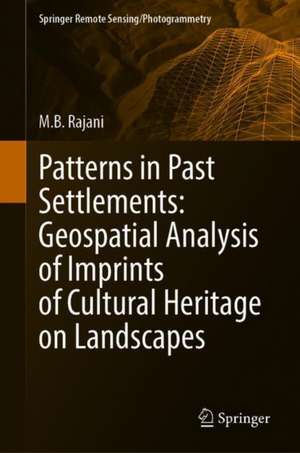Patterns in Past Settlements: Geospatial Analysis of Imprints of Cultural Heritage on Landscapes: Springer Remote Sensing/Photogrammetry
Autor M.B. Rajanien Limba Engleză Hardback – 30 sep 2020
| Toate formatele și edițiile | Preț | Express |
|---|---|---|
| Paperback (1) | 1043.14 lei 6-8 săpt. | |
| Springer Nature Singapore – oct 2021 | 1043.14 lei 6-8 săpt. | |
| Hardback (1) | 1108.99 lei 6-8 săpt. | |
| Springer Nature Singapore – 30 sep 2020 | 1108.99 lei 6-8 săpt. |
Din seria Springer Remote Sensing/Photogrammetry
- 15%
 Preț: 653.98 lei
Preț: 653.98 lei - 24%
 Preț: 847.78 lei
Preț: 847.78 lei - 24%
 Preț: 911.54 lei
Preț: 911.54 lei - 15%
 Preț: 644.18 lei
Preț: 644.18 lei - 24%
 Preț: 694.68 lei
Preț: 694.68 lei - 18%
 Preț: 785.11 lei
Preț: 785.11 lei - 18%
 Preț: 950.52 lei
Preț: 950.52 lei - 18%
 Preț: 895.58 lei
Preț: 895.58 lei - 18%
 Preț: 1112.60 lei
Preț: 1112.60 lei - 18%
 Preț: 946.87 lei
Preț: 946.87 lei - 18%
 Preț: 1244.71 lei
Preț: 1244.71 lei - 18%
 Preț: 1114.02 lei
Preț: 1114.02 lei - 24%
 Preț: 728.29 lei
Preț: 728.29 lei - 24%
 Preț: 895.51 lei
Preț: 895.51 lei - 18%
 Preț: 1105.83 lei
Preț: 1105.83 lei - 20%
 Preț: 560.05 lei
Preț: 560.05 lei - 18%
 Preț: 1043.14 lei
Preț: 1043.14 lei - 18%
 Preț: 944.34 lei
Preț: 944.34 lei - 18%
 Preț: 888.18 lei
Preț: 888.18 lei - 18%
 Preț: 892.46 lei
Preț: 892.46 lei - 18%
 Preț: 1005.61 lei
Preț: 1005.61 lei - 24%
 Preț: 844.06 lei
Preț: 844.06 lei
Preț: 1108.99 lei
Preț vechi: 1352.42 lei
-18% Nou
Puncte Express: 1663
Preț estimativ în valută:
212.23€ • 219.25$ • 176.63£
212.23€ • 219.25$ • 176.63£
Carte tipărită la comandă
Livrare economică 25 martie-08 aprilie
Preluare comenzi: 021 569.72.76
Specificații
ISBN-13: 9789811574658
ISBN-10: 9811574650
Ilustrații: XXIII, 168 p. 86 illus., 81 illus. in color.
Dimensiuni: 155 x 235 mm
Greutate: 0.45 kg
Ediția:1st ed. 2021
Editura: Springer Nature Singapore
Colecția Springer
Seria Springer Remote Sensing/Photogrammetry
Locul publicării:Singapore, Singapore
ISBN-10: 9811574650
Ilustrații: XXIII, 168 p. 86 illus., 81 illus. in color.
Dimensiuni: 155 x 235 mm
Greutate: 0.45 kg
Ediția:1st ed. 2021
Editura: Springer Nature Singapore
Colecția Springer
Seria Springer Remote Sensing/Photogrammetry
Locul publicării:Singapore, Singapore
Cuprins
Landscape archaeology: role of remote sensing and GIS.- Landscape morphology and spatial patterning of archaeological signatures when viewed from above.- The science and technology of remote sensing in context of archaeology.- GIS: an array of exceptional tools for archaeology.- RS and GIS for preservation, conservation and management.
Notă biografică
M B Rajani is an Associate Professor at National Institute of Advanced Studies, Bangalore. She received the Rachapudi Kamakshi Memorial Young Geospatial Scientist Award 2011 for her Ph.D. work. She is a member of Indian National Young Academy of Science 2018–2022, a Young Affiliate 2019–2023 of The World Academy of Sciences and recipient of the Indian Society of Remote Sensing's P R Pisharoty Memorial Award 2019. Rajani’s research has two inter-related facets: analysing cultural landscapes using geospatial data to identify new features of archaeological interest and advancing the usage of such analysis for preserving built heritage in the face of rapidly growing infrastructural development and urbanization. Her primary scientific contribution has been to develop a methodology for detecting tell-tale signs of past human activities on landscapes from satellite imagery and integrating these findings with other spatial data to generate new inferences and novel hypotheses about the past. Her work has therefore expanded the field of archaeology to include the study of human impact on landscapes. Her findings based on remote sensing analysis at the site Talakadu (published in 2009–10) were confirmed 8 years later through conventional excavations, and her analysis of Nalanda has revealed the larger archaeological expanse around the protected site.
Textul de pe ultima copertă
This book is an introduction to a new branch of archaeology that scrutinises landscapes to find evidence of past human activity. Such evidence can be hard to detect at ground-level, but may be visible in remote sensing (RS) imagery from aerial platforms and satellites. Drawing on examples from around the world as well as from her own research work on archaeological sites in India (including Nalanda, Agra, Srirangapatna, Talakadu, and Mahabalipuram), the author presents a systematic process for integrating this information with historical spatial records such as old maps, paintings, and field surveys using Geographic Information Systems (GIS) to gain new insights into our past. Further, the book highlights several instances where these insights are actionable -- they have been used to identify, understand, conserve, and protect the fragile remnants of our past. This book will be of particular interest not only to researchers in archaeology, history, art history, and allied fields, but to governmental and non-governmental professionals working in cultural heritage protection and conservation.
Caracteristici
Highlights scientific developments and technologies that have provided new tools to decipher the past Elaborates the unique advantages that these technologies offer for archaeological applications Lists the available technologies and data sources; processing, interpretation, and feature detection specific to archaeological settlements Explains the geomorphological processes the landscape undergoes which preserves or obscures traces of the past
